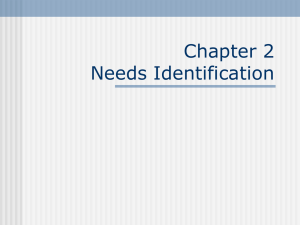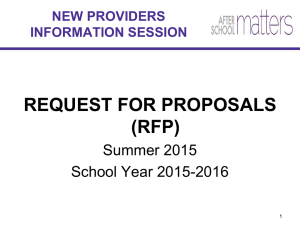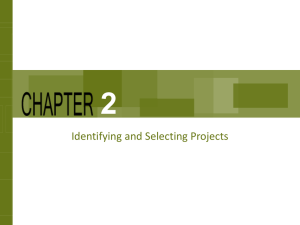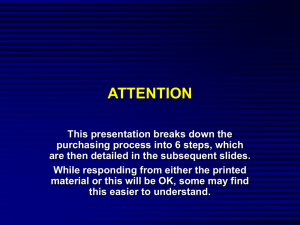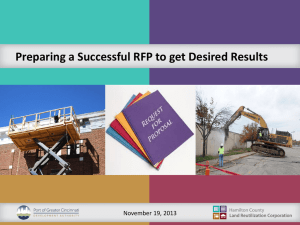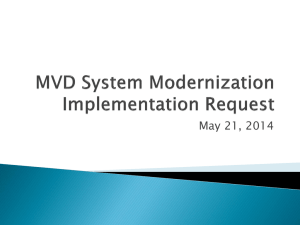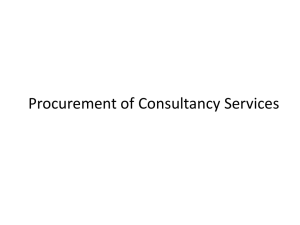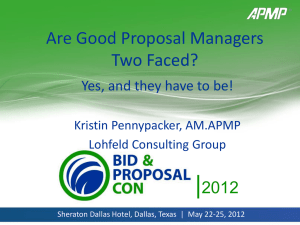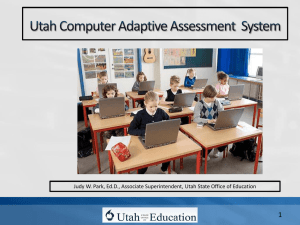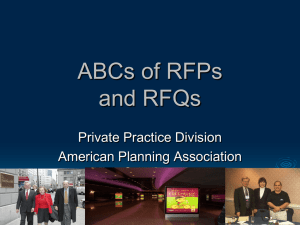RFP Best Practices and Emerging Trends
advertisement
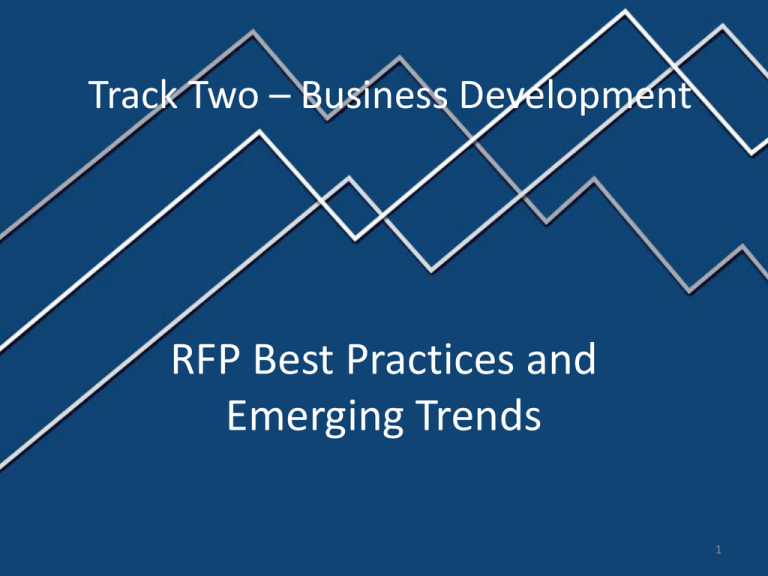
Track Two – Business Development RFP Best Practices and Emerging Trends 1 RFP Best Practices and Emerging Trends Introductions – • Christopher Batio Director, Marketing & Business Development Pierce Atwood LLP • Jeff Baron Director, National Pursuit Team for New Business Development PricewaterhouseCoopers LLP 2 RFP Best Practices and Emerging Trends Agenda – • The Professional Services Firm Perspective • The Law Firm Perspective • Bringing the Perspectives Together – Discussion/Q&A 3 RFP Best Practices and Emerging Trends The Professional Services Firm Perspective – • • • • • • • • Why Proposals Still Matter What Clients Seek The Go/No-Go Decision Value Propositions Client Debriefs The Emergence of Procurement-Driven Proposals Role and Responsibilities of Marketing & Sales Lessons Learned 4 RFP Best Practices and Emerging Trends Why Proposals Still Matter – • • • • It can “kick you out” in the first round. The purpose of the proposal is to sell. The proposal can differentiate your firm. Internally, the process of building a proposal helps solidify the messages your service team will use throughout the pursuit. • A clear and concise Cover Letter and Executive Summary presents differentiators up front. • Know that even a favored firm may not make it to orals with a procurementdriven process. • The proposal must be well done. 5 RFP Best Practices and Emerging Trends What Clients Seek – • Value: Clearly differentiate your people, experience and value in both written documents and oral presentations. • Relationship: Develop relationships early and cultivate them during in the process, also consider the impact of relationships by your Firm and the competition before proposing. • Responsiveness: Demonstrate that you are listening to the client and make them feel they are important, also take the time to produce quality proposals. • Experience: Demonstrate knowledge and experience by providing a roadmap of how we will get the job done. • Commitment: Demonstrate commitment and enthusiasm, "hunger for the work" is often cited as an intangible differentiator. 6 RFP Best Practices and Emerging Trends The Go/No-Go Decision – • Personnel with the needed skills should already be in place, and critical mass in the specialty areas exists. • The right Partners and team must be made available to work on the pursuit strategy and proposal, not just to perform the engagement. • Relationships are critical. • If it is considered a "long shot" we probably won't win. • The "right" questions must be asked at the earliest stages. 7 RFP Best Practices and Emerging Trends Value Propositions – • The Value proposition should resonate with the client and differentiate your Firm. • Value proposition meetings are critical. Conduct at the beginning of the process followed by regular pursuit strategy calls. Focus on the pursuit, messaging, competitive landscape and relationships. Revisit the value proposition frequently to "test“ value and differentiators. The value proposition should be woven through the document. 8 RFP Best Practices and Emerging Trends Client Debriefs – • Conduct a formal, independent debrief following the client decision. • Carefully consider who conducts the debrief. • Conduct debriefs regardless of whether you win or lose. • Debriefs allow knowledge sharing around the procurement process with the client. • If a client won't meet in person, go for a telephone call. 9 RFP Best Practices and Emerging Trends The Emergence of Procurement-Driven Proposals – • How we coach our teams and lead the process is impacted. • Even a favored firm may not make it to orals with a procurement-driven process. • Understand who the economic buyer is. • Be sure that the buyer remains actively involved. • Know if a scoring matrix is to be used, and the implications. • Keep focus on the client’s business requirements. 10 RFP Best Practices and Emerging Trends The Emergence of Procurement-Driven Proposals – (continued) • Respond to the questions asked, but also continue offering specific business and industry insights. • Effectively use the information gathered. • Align proposal with the strategy of your actual client. • Align proposal with buying strategy of your client. • Make it easy to read and answer all the questions. • Follow the procedures and make use of the ability to ask questions. 11 RFP Best Practices and Emerging Trends Role and Responsibilities of Marketing in the Proposal Process – • Project manage the overall proposal effort; facilitate and manage team information sharing. • Help team develop the value proposition. • Independently develop responses or facilitate responses from the Pursuit Team related to complex RFP questions. • Facilitate debrief with team after scoping meetings to ensure feedback is discussed and addressed. • Give independent review and make assessments for improvement. • Leverage Knowledge Management resources, Research & Pursuit Management Tools. 12 RFP Best Practices and Emerging Trends Role and Responsibilities of Marketing & Sales in the Proposal Process – (Continued) • Project manage the document; gather all final feedback and aggregate into master file; manage production with graphic designer. • Manage final production and conduct quality checks. • Update CRM or other tracking databases. • Prepare for oral presentations and/or additional requests for information. • Facilitate debrief with team after orals or other meetings to ensure feedback is discussed and addressed. • Communicate the “lessons learned” of the win or loss. 13 RFP Best Practices and Emerging Trends Lessons Learned – • Be enthusiastic - externally and internally. • Employ tactics for success to ensure a robust pursuit strategy. • Provide value through each interaction. • Present your best team of people. • Leverage relationships and knowledge at the beginning of the process. • Hold “Go/No-Go” as process begins. • Breadth and depth of relationships is typically a differentiator. • Understand the players and dynamics, especially with a procurement driven process. • Bring the best to orals, and conduct formal “orals” rehearsals with all team members physically present. • Timely and responsive follow-up is critical. • Fees are extremely competitive, and rates are declining especially with the involvement of procurement. • Your competitors are getting more sophisticated and aggressive. 14 RFP Best Practices and Emerging Trends The Law Firm Perspective – • • • • • • What Are RFPs Used For In the Legal Services Environment? How Are Legal Services Proposals Different? Procurement, Convergence and Consultant-Driven RFPs Building a Proposal Process Without Dedicated Resources Supporting the Go/No-Go Decision Discerning What Your Lawyers Know vs. What They Think They Know • Pitfalls and How to Avoid Them 15 RFP Best Practices and Emerging Trends RFPs in the Legal Services Environment – • • • • Simple qualifications for a evaluating a new provider. Competition for a specific project, deal or litigation. Assembling a panel or preferred provider list. Assessing existing outside counsel following a management or ownership change. • Procurement or consultant driven exercise to reduce legal costs. • Convergence designed to reduce # of outside law firms and increase leverage over fees. • Information gathering exercise related to specific issues, i.e. diversity, sustainability. 16 RFP Best Practices and Emerging Trends How Legal Services Proposals Differ – • Often focused on communicating individual skills and experiences in a team or institutional format. • Need to customize bios and link experience there to body of the proposal. • Diverse fee proposals (especially these days) • Seek to communicate the intangible clear and concisely. • Little historical process to draw upon. 17 RFP Best Practices and Emerging Trends Procurement, convergence and consultant-driven RFPs – • Why would law departments involve procurement in choosing outside counsel? • How can you recognize the stamp of a consultant or procurement officer? • What are the true goals of this type of RFP? • The DuPont and Pfizer models. • Myths of convergence (a nod to Rees Morrison). – – – – It’s just an exercise, if we go through the motions nothing will change. The proposal doesn’t matter if our relationship is strong. Q&As are the best RFPs to respond to. The GC is the decision maker. 18 RFP Best Practices and Emerging Trends Building a Proposal Process Without Dedicated Resources – • Catalog your tools, skills and resources. • Understand your firm’s business development goals and the place RFPs play in those goals. • Build a proposal library that is accessible and easily updated. • Start by offering the basics and slowly work towards delivering strategic value, not just product. • Seek to be more than just the “Recording Secretary.” • Communication, persuasion, education. • Track your progress and report on it regularly. 19 RFP Best Practices and Emerging Trends Supporting the Go/No-Go Decision – • • • • Foster opportunities for attorneys to make a Go/No-Go decision. Share your analysis of the RFP. Research the business and its decision makers. Arm your team with data that supports a conversation about the value of the potential business contained in the RFP. • Encourage the attorneys to ask questions of each other and the potential client. 20 RFP Best Practices and Emerging Trends Discerning What Your Lawyers Know vs. What They Think They Know – • Are they jumping right to message? • Are their statements grounded in data and experience or speculation? • Encourage the airing of differing views. ______________________________________ • Listening begins with asking the right questions. • Has the client articulated their key needs/concerns? • Can your firm address the client’s key needs/concerns or develop a strategy to do so? • Link specific people, experiences and capabilities to the client’s key needs/concerns. 21 RFP Best Practices and Emerging Trends Pitfalls and How to Avoid Them – • Pitfall - KitchenSinkitis. – Solution – Strong value proposition. • Pitfall - Too Many Cooks. – Solution – Apply the Law of Input Reduction. • Pitfall - Bad Proposal Inertia. – Solution – Strong Go/No-Go process. • Pitfall - The Political Proposal. – Solution – Clear direction from firm leaders. • Pitfall - The Remote Control Proposal. – Solution – Clear communication with Team on expectations and process. 22 RFP Best Practices and Emerging Trends For more information • Christopher Batio Director of Marketing & Business Development, Pierce Atwood LLP cbatio@pierceatwood.com 207-791-1244 • Jeff Baron Director, National Pursuit Team for New Business Development PricewaterhouseCoopers LLP jeffrey.a.baron@us.pwc.com 202-841-1050 23 24
